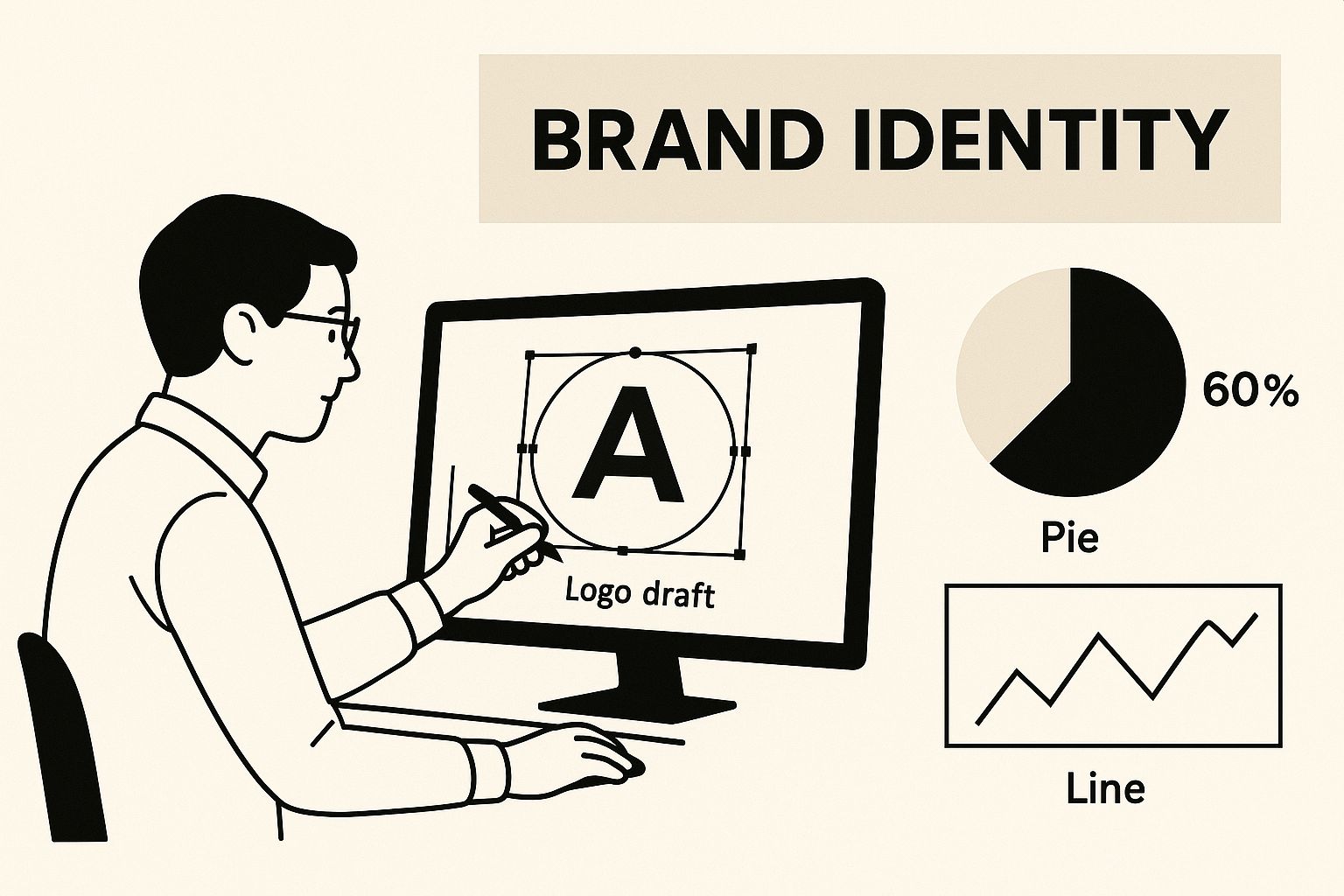Why Strategic Branding Is Your Startup's Hidden Advantage
Many startup founders consider branding a non-essential expense, something to address after achieving product-market fit and securing funding. However, this can be a costly mistake, hindering a startup's market positioning from the very beginning. Building a strong brand from day one is a crucial investment in long-term success. Think of it as the foundation of a building: essential for stability and growth.
First Impressions Matter: Investors and Customers
First impressions are critical, especially for startups competing in crowded markets. A well-defined brand helps create a positive and lasting impression on both potential investors and customers. Investors are more inclined to support startups with a clear vision and compelling brand narrative. A strong brand communicates trust, credibility, and value to customers, influencing their buying decisions. This is especially relevant in competitive markets like the U.S., Europe, or Asia.
Branding Impacts Conversion Rates
Strategic branding goes beyond just aesthetics. It directly affects conversion rates by shaping customer perception and fostering brand loyalty. A cohesive brand identity, consistent messaging, and a clear value proposition resonate with your target audience, making them more likely to choose your product or service. Investing in branding can directly impact your bottom line. Consistent branding drives significant revenue growth, with 68% of companies reporting a 10-20% increase in revenue due to brand consistency. Startups often underestimate the power of a unified visual identity and messaging. Fragmented branding erodes customer trust and dilutes brand recognition. Find more detailed statistics here: Branding Statistics
Brand Building Starts on Day One
Delaying brand development can hinder your growth. As Josh Stutt, head of marketing at The49, notes, "Building your brand is a perpetual process that starts on day one." Early-stage branding establishes a strong foundation for future marketing, simplifying customer acquisition, securing funding, and scaling your business. This proactive approach also sets the stage for sustainable differentiation in increasingly competitive markets.
Justifying Branding Investments
Resources are often limited for startups, but practical frameworks exist for justifying branding investments. By demonstrating how strategic branding directly influences key metrics like conversion rates, customer acquisition cost, and customer lifetime value, you can build a compelling case for allocating resources to brand development. Focusing on cost-effective strategies, such as leveraging social media and user-generated content, allows startups to maximize their impact with minimal investment.
Crafting Your Startup's Brand Identity That Resonates

Building a brand for a startup is more than just a logo and color scheme. It's about creating a framework that connects with your audience and grows with your business. This involves understanding your brand purpose, defining your core values, and crafting a compelling origin story. These elements combine to create a unique identity that sets you apart.
Defining Your Brand Purpose
Your brand purpose is the "why" behind your company. It's the motivation for your team and the connection point for your customers. Think of TOMS Shoes. Their purpose isn't simply selling shoes; it's about giving back. For every pair purchased, TOMS donates a pair to a child in need.
This resonates with customers who care about social impact. It's a purpose beyond profit. Defining your brand purpose early ensures that everything you do, from marketing to product development, aligns with your core beliefs.
Establishing Core Values
Your core values guide every decision within your startup. They are the foundation of your company culture and shape interactions with customers, partners, and employees. If transparency is a core value, it should be reflected in your communication, pricing, and business practices.
This builds trust and strengthens relationships. Clearly defined values also attract like-minded talent, creating a more cohesive and motivated team.
Crafting Your Origin Story
Every startup has a beginning. This origin story is your chance to connect with customers personally. It's about the human element behind your brand and why you started your business. Perhaps it's a personal challenge, a market gap, or a passion project that took off.
A well-crafted origin story humanizes your brand. It creates relatability and builds an emotional connection. Consider Airbnb. Their story began with the founders renting out air mattresses in their apartment. This relatable beginning resonates with their audience.
Implementing a Brand Identity Framework
A brand identity framework acts as a blueprint for consistency. It’s essential for startups, especially during rapid growth. This framework outlines your brand identity components and their application. It might include logo guidelines, brand voice, messaging, and visuals.
Having a framework ensures everyone in your company understands and follows the brand guidelines, maintaining consistency.
To help you visualize how to build your brand identity framework, take a look at the table below:
Brand Identity Framework Components: This table outlines the essential elements of a startup brand identity framework with corresponding actionable steps.
| Component | Description | Implementation Steps | Startup Example |
|---|---|---|---|
| Brand Purpose | The "why" behind your business, extending beyond profit. | Define your mission, vision, and values. Develop a concise purpose statement. | Patagonia: "We're in business to save our home planet." |
| Core Values | Guiding principles that inform decisions and actions. | Identify 3-5 key values. Communicate these values internally and externally. | Buffer: Transparency, authenticity, empathy. |
| Origin Story | The narrative of how your startup began. | Craft a compelling story highlighting the problem you solve. Share your founder's journey. | Warby Parker: Frustration with overpriced eyewear led to a direct-to-consumer model. |
| Brand Voice | The personality and tone of your brand communication. | Define your target audience. Choose words and phrases that resonate. | Mailchimp: Playful, helpful, and supportive. |
This table provides a practical guide to building a robust brand identity framework. Focusing on these key components will help ensure consistency and clarity in your brand messaging.
Building a strong brand identity takes ongoing effort. By focusing on purpose, values, and storytelling, startups can create a brand that resonates with their audience, builds loyalty, and drives growth. A well-defined branding strategy isn't a luxury; it's a crucial investment for any startup seeking sustainable success. As you develop your brand, consider platforms like Creativize to connect with talent who can help bring your vision to life.
Forging Emotional Connections That Convert to Loyalty

Why do some startups build passionate advocates while others struggle with customer retention? The key differentiator is emotional branding. When done authentically, it creates a powerful bond between brand and consumer. This is especially vital for startups, who need to make the most of limited resources.
Connecting with your audience emotionally builds a true competitive advantage. It fosters loyalty that goes beyond individual transactions.
Identifying Emotional Triggers
Effective emotional branding starts with understanding your audience. What are their values, motivations, and pain points? What truly resonates with them?
This means delving deeper than demographics. It requires understanding psychographics: their attitudes, lifestyles, and aspirations. By identifying the emotional triggers that speak to your audience segments, you can craft messaging that truly connects. For example, a sustainable product startup might tap into consumer concern for the environment.
Translating Insights into Authentic Messaging
After identifying these triggers, translate them into authentic messaging. This means crafting narratives that resonate deeply, moving beyond simply listing product features.
Instead, focus on how your product addresses core emotional needs. Ensure your brand's voice, visuals, and communication style align with these values. This consistency reinforces the emotional connection, building trust and loyalty. Trust and strong emotional connections are crucial. In fact, 81% of consumers need to trust a brand before buying. Startups aligning with customer values like sustainability or inclusivity see 65% stronger emotional bonds. For more statistics, see these Branding Statistics.
Value Alignment and Ethical Practices
Consumers are drawn to brands that reflect their values. This is a great opportunity for startups to build deeper connections by aligning with social causes and ethical practices.
Authenticity is paramount, though. Consumers easily spot inauthentic “value-washing.” For startups, this means demonstrating commitment through real action and transparent communication. This might include partnering with non-profits, implementing sustainable practices, or promoting diversity and inclusion.
The Power of Customer Loyalty
Building these emotional connections creates tangible benefits for startups. Loyal customers become advocates, driving organic growth through word-of-mouth.
They're also more likely to give valuable feedback, contributing to product development and brand evolution. Data shows that 88% of customers become loyal after just three purchases. By focusing on emotional branding early on, startups can build a loyal customer base that drives sustainable growth. Platforms like Creativize can help you connect with talented professionals to refine your branding strategy.
Building a Digital Brand Presence That Drives Engagement

Building a strong digital brand presence is essential for startups, especially those working with limited budgets. This involves prioritizing high-impact, low-cost strategies that boost engagement and build brand recognition. It's about making every interaction matter.
Leveraging Social Media for Maximum Impact
Social media provides incredible opportunities for startups to connect directly with their target audience. However, a strategic approach is key. This means choosing the right platforms, creating engaging content, and building a community around your brand. Think of social media as your digital storefront – it showcases your brand's personality and values.
Building a Consistent Posting Cadence
Consistency is key to maintaining a strong social media presence. Startups often struggle to maintain a regular posting schedule without overwhelming their small teams. Creating a content calendar and scheduling posts in advance can address this. Using user-generated content can also reduce the burden of content creation and foster authenticity.
Increasing Organic Reach Without Paid Promotion
While paid advertising can be effective, organic reach is essential for budget-conscious startups. Tactics like using relevant hashtags, engaging with followers, and posting at optimal times can significantly increase visibility without spending any money. Understanding the best times to post on Instagram versus LinkedIn, for example, can maximize your content's reach. This targeted approach ensures your message reaches the right people at the right time.
To help startups navigate the complexities of social media, let's compare some key platforms:
This table below, "Social Media Platform Strategy Comparison for Startups," compares different social media platforms and their effectiveness for startup branding.
| Platform | Audience Demographics | Content Format | Organic Reach Potential | Resource Requirements | Best For |
|---|---|---|---|---|---|
| Primarily 18-34, visually-oriented | Images, short videos, stories | Moderate, declining | Consistent content creation, engagement | Visually-driven brands, influencer marketing | |
| Broad audience, diverse age groups | Text, images, videos, live streams | Low, requires engagement | Community management, targeted advertising | Building brand awareness, reaching wide audiences | |
| News-focused, younger demographics | Short-form text, images, GIFs | Moderate, dependent on trending topics | Real-time engagement, rapid response | Sharing updates, engaging in conversations | |
| Professionals, B2B focus | Long-form articles, professional networking | Moderate, increasing with engagement | Content strategy focused on industry insights | Building professional networks, B2B marketing |
This comparison highlights the importance of choosing the right platforms based on your target audience and available resources. Instagram is ideal for visually driven brands, while LinkedIn is best for professional networking and B2B marketing.
Measuring ROI on Digital Branding Efforts
Tracking the effectiveness of your digital branding initiatives is critical. Go beyond vanity metrics like follower count and focus on measurable outcomes, like website traffic, lead generation, and conversions. By tracking these key performance indicators (KPIs), startups can gain valuable insights into what's working and what isn't. This data-driven approach ensures that your branding strategy aligns with your business goals.
This data chart visualizes key data on social media engagement.
(Infographic: Bar Chart – Social Media Engagement by Platform)
-
Data Visualized: Average engagement rate (likes, comments, shares) per post on different platforms (Instagram, Facebook, Twitter, LinkedIn).
-
Key Data Points: Instagram boasts the highest average engagement rate, followed by Facebook, then Twitter and LinkedIn.
-
Trends/Patterns: The chart reveals a clear correlation between visual content and engagement. Instagram, a visually-driven platform, outperforms text-based platforms like Twitter. This underscores the importance of visual content.
Social media dominates brand recognition strategies, with 44% of marketers prioritizing it as their top channel. Facebook is preferred by 79% of marketers due to its 2.9 billion monthly users. Learn more: Branding Statistics
Leveraging User-Generated Content and Community Building
User-generated content (UGC) is invaluable for startups. It builds authenticity, fosters trust, and amplifies your brand message through the voices of your customers. Think of UGC as word-of-mouth marketing amplified by social media's reach. Building a genuine community around your brand fosters a loyal following and drives organic growth.
Crisis Management Protocols for Startups
Even successful startups face challenges. A crisis management plan is crucial for protecting your brand reputation. This involves identifying potential risks, developing communication protocols, and responding quickly and transparently to negative feedback. This proactive approach can mitigate damage and maintain customer trust during challenging times. This can be as simple as having pre-written responses for common customer complaints.
Data-Driven Insights for Digital Branding Success
Optimizing content for each platform is crucial to maximize organic reach and engagement. Platforms like Creativize can connect you with talented professionals to strengthen your branding strategy. By implementing these strategies, startups can build a robust digital brand presence that drives engagement and sets the stage for long-term growth. A well-executed digital branding strategy isn't a luxury but a necessity for any startup looking to thrive in a competitive market.
Maintaining Brand Consistency During Rapid Growth
As your startup expands, keeping your brand consistent gets tricky. When your team grows rapidly, ensuring everyone stays on-brand can be a real challenge. But brand consistency is key for building recognition and trust, particularly during periods of fast growth.
Developing Flexible Brand Guidelines
Begin by creating brand guidelines that are both detailed and adaptable. These guidelines should cover everything: logo usage, color palettes, brand voice, and messaging. But they also need to be flexible enough to adapt to the changing needs of a growing startup. Think of your brand guidelines as a living document, constantly evolving, not a set of fixed rules. Platforms like Creativize can connect you with experts to help build these crucial foundations.
Implementing Quality Control Processes
Quality control doesn't have to mean slowing everything down. Establish efficient review processes for marketing materials and other brand assets. This could involve assigning brand champions within each team. These individuals would ensure all outgoing communications stick to the guidelines. This decentralized approach maintains consistency without hindering creativity or speed.
Training Your Team as Brand Ambassadors
Everyone on your team, not just marketing, should be a brand ambassador. Regularly train your employees on the brand guidelines and empower them to uphold the brand identity. This training could be through workshops, online resources, or even interactive training programs. This creates shared understanding and ownership of the brand across the company.
Real-World Examples of Maintaining Brand Integrity
Many startups have successfully maintained their brand integrity while scaling rapidly. Look at Slack, which kept its playful yet professional voice throughout its growth. This consistency built trust and recognition, contributing to its wide adoption. It demonstrates how a strong brand can withstand rapid expansion.
Conducting Brand Audits to Identify Inconsistencies
Regular brand audits are essential for catching inconsistencies early, before they harm your brand equity. These audits involve reviewing every brand touchpoint: your website, social media, customer service interactions, and even internal communications. This helps you find areas where the brand might be straying from the established guidelines.
For example, what if your customer service team uses a different tone than your marketing materials? This inconsistency can confuse customers and erode trust. A brand audit would catch this, letting you fix it before it impacts your brand.
Here’s a simple framework for a brand audit:
| Step | Action |
|---|---|
| 1. Identify All Brand Touchpoints | List every place your brand interacts with customers and stakeholders. |
| 2. Review Each Touchpoint | Check for consistency with brand guidelines (voice, visuals, messaging). |
| 3. Document Inconsistencies | Note any deviations and their potential impact. |
| 4. Develop Corrective Actions | Create steps to address inconsistencies and improve brand consistency. |
| 5. Implement and Monitor | Put the changes into effect and track how well they work. |
This structured approach ensures a comprehensive and efficient brand audit, protecting your brand identity as your startup grows. Maintaining brand consistency during rapid growth requires proactive planning, clear guidelines, and continuous monitoring. Using these strategies, startups can build a strong, recognizable brand that drives growth and fosters customer loyalty. Connect with talent on platforms like Creativize to further strengthen your branding during this key growth phase. By focusing on these elements, startups can build a brand that not only survives rapid expansion but thrives.
Measuring Brand Impact: Beyond Vanity Metrics
For startups, demonstrating the return on investment (ROI) of branding is critical, especially when budgets are tight. This means looking beyond vanity metrics like follower counts and likes. These surface-level numbers offer little insight into real business impact. Instead, focus on metrics directly tied to business outcomes. This data-driven approach justifies branding expenses and shapes future strategy.
Cost-Effective Brand Tracking for Startups
Building a brand doesn't require expensive tools. Startups can use free or low-cost survey platforms like SurveyMonkey or Typeform to gather customer perception data. These tools offer valuable insights into brand awareness, brand perception, and customer satisfaction. Analyzing this data reveals strengths and areas for improvement.
For example, tracking brand awareness over time helps measure campaign effectiveness. Small changes can signal big shifts in customer understanding. This allows startups to quickly adjust their strategies and maximize their impact.
Budget-Friendly Competitor Analysis
Competitor analysis doesn't have to be costly. Startups can analyze competitor websites, social media, and customer reviews. This helps understand competitor positioning and messaging. It also provides context for your own branding strategy. This allows you to identify opportunities to differentiate and stand out.
For example, if competitors focus on features, your startup could highlight emotional benefits. This creates a unique brand identity and resonates with a different audience. Smart analysis allows startups to carve their own niche in the market.
Understanding Customer Perception Data
Raw data is meaningless without interpretation. Startups should analyze customer feedback for trends and patterns in brand perception. It's important to understand not just what customers think, but why.
This deeper understanding helps refine messaging and target specific customer needs. Focusing on qualitative data, like open-ended survey responses, provides richer insights. These insights drive more effective branding decisions.
Tracking Brand Equity Development
Measuring brand equity can be complex. However, frameworks exist to track its development. One approach involves monitoring key metrics. Track changes in brand awareness, customer lifetime value (CLV), and willingness to pay a premium.
Monitoring these metrics helps quantify the impact of branding initiatives. For instance, increased CLV could indicate stronger brand loyalty. This data demonstrates the long-term value of effective branding.
Linking Branding and Business Outcomes
Connecting branding efforts to tangible business outcomes is crucial. Track how branding initiatives impact revenue and customer retention. This proves the value of your strategy. This might involve analyzing website traffic, conversion rates, and customer churn after a rebranding campaign.
These correlations reveal cause-and-effect relationships. This justifies future branding investments. For example, decreased churn after a new messaging strategy demonstrates its positive impact. This data-driven approach makes a strong case for continued investment.
Communicating Brand Performance
Startups must communicate brand performance to investors and stakeholders. Present data clearly and concisely, focusing on key metrics and their link to business objectives. Visualizations like charts and graphs can simplify complex data. A strong narrative supported by solid data builds investor confidence and justifies continued investment.
This transparency also builds trust and strengthens relationships. Platforms like Creativize can connect you with professionals to help refine your strategy and communicate its impact. This ensures your brand building directly contributes to your startup's growth.
Your 90-Day Startup Branding Roadmap
This roadmap helps startups with limited resources put branding theory into practice. It prioritizes high-impact activities, enabling progress even with small teams and tight budgets. This structured approach ensures efficient resource allocation and maximizes your branding investment.
Phase 1: Foundational Elements (Days 1-30)
The first 30 days are about establishing your brand's core elements. This crucial groundwork ensures all future branding is built on a solid foundation. As Josh Stutt, head of marketing at The49, notes, "Building your brand is a perpetual process that starts on day one."
-
Define Your Brand Purpose: Articulate the "why" behind your company. Go beyond profit and define your mission, vision, and values. This clarifies your reason for existing and sets the stage for a compelling brand narrative.
-
Identify Your Target Audience: Determine your ideal customer. Understand their needs, motivations, and pain points. This focused approach lets you tailor messaging and resonate with your target market.
-
Develop Core Messaging: Craft key messages that communicate your value proposition and resonate with your target audience. This includes defining your brand voice and tone, ensuring consistent communication.
Phase 2: Building Your Brand Identity (Days 31-60)
The second phase focuses on translating your foundational elements into a tangible brand identity. This includes developing visual elements and crafting your brand story to create a recognizable and memorable brand.
-
Create Visual Identity: Design a logo, choose a color palette, and establish typography guidelines that reflect your brand personality. These visual cues are often the first impression for customers and need to align with your overall message.
-
Craft Your Brand Story: Develop a compelling narrative that showcases your origin story, values, and unique selling proposition. This helps create an emotional connection with your audience and builds brand authenticity.
-
Build a Basic Online Presence: Launch a simple website and create social media profiles on platforms relevant to your target audience. This creates a digital home for your brand and allows you to start engaging online.
Phase 3: Engaging Your Audience and Measuring Impact (Days 61-90)
The final phase involves bringing your brand to life by engaging your target audience and measuring your efforts. It's about putting your brand out into the world and gathering feedback.
-
Develop a Content Strategy: Create valuable content that educates, entertains, or informs your target audience. This could include blog posts, social media updates, or videos. Consistent content builds brand recognition and establishes thought leadership.
-
Engage Your Audience: Interact with your followers on social media, respond to comments and questions, and participate in relevant online communities. This active engagement builds relationships and fosters brand loyalty.
-
Track and Measure: Monitor key metrics like website traffic, social media engagement, and brand mentions. Analyze this data to gauge the effectiveness of your branding strategy and make adjustments.
Handling Branding In-House vs. Outsourcing
Early-stage startups can often handle branding in-house, especially with available online resources and design tools like Canva. As your startup grows, consider engaging professionals for specialized tasks like logo design or website development using platforms like Dribbble. This provides expertise and frees your team to focus on core business activities.
Avoiding Common Branding Pitfalls
Many startups fall into the trap of generic positioning. Avoid vague language and clichés. Focus on differentiating your brand by highlighting your unique qualities. Another common mistake is neglecting brand consistency. Establish clear guidelines from the start and ensure your team knows how to apply them.
Evolving Your Brand as You Grow
Your branding strategy should not be static. As your startup grows, your brand needs to adapt. Regularly review your branding guidelines, gather customer feedback, and make adjustments based on market conditions and business objectives. This keeps your brand relevant.
Ready to connect with top talent? Creativize offers a platform to find creative professionals specializing in branding design, 2D animation, and more. Visit Creativize to explore portfolios and find the perfect creative partner.

